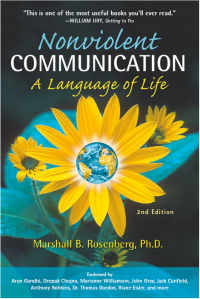Progress with Nonviolent Communication
Progress with Nonviolent Communication
Upon beginning to read Marshall Rosenberg’s book “Nonviolent Communication” two or three weeks ago, it felt like coming home.
As a coach, consultant (long time ago) and more recently Organisational Therapist, I have long felt that the key to meaningful change in people’s lives – and incidentally, in organisations – is the quality of the dialogue they manage (sic) to have.
Dialogue is a Skill
Dialogue – more explicitly, meaningful dialogue, requires much practice to acquire the necessary skills. And it’s hard, no matter into whichever “school” of skilful dialogue you might enrol yourself. Absent such hard-won skills, dialogue can often be insipid and superficial, or worse, a minefield.
I stand in awe at @benjaminm‘s dedication to learning the art of skilful dialogue the Argyris way. For me, the tenor of Argyris’s ideas always made me feel a little uncomfortable, notwithstanding their obvious strengths.
It wasn’t until I came across Rosenberg that I could even begin to articulate my reservations. Again, for me, Argyris seems a tad cold and clinical in its style, compared to the warmth and fuzziness of Nonviolent Communication. I mean, who could fail to love glove puppets (see the Jackal and the Giraffe, below), or indeed Rosenberg himself?
Progress in Practice
Since reading the NVC book, I’ve been diligently practicing, writing (you may have noticed) and thinking about the techniques and implications of Nonviolent Communication.
I’m finding it hard to slough off a lifetime of judgmentalism and thinking, and focus more on feelings. One of the most challenging aspects, for me, has been trying to identify just what I am feeling in any given situation. I had no idea how unpractised I was at finding a suitable label – free from thinking and judgement – about my feelings.
I’m finding much benefit in the practice, though. Especially in terms of dealing with some folks who until recently I would have judged as “difficult” people. Choosing to see them as, instead, needful and worthy of compassion seems to suit me well.
Not that it’s all been a bed of roses. It seems I need more skill before I can truly engage with the more extreme cases of angst or need. Or maybe it’s just always going to be that much harder to apply the ideas through e.g. Twitter.
And when I’ve not been able to produce the kind of dialogue modelled in the book and by Rosenberg in his videos, I’ve found it quite natural to jump to self-judgement, rather than step back and take another look at my own feeling and needs. Still, even Rosenberg relates a number of tales of his own foibles in that regard. More practice required here.
Still, I have my Giraffe Ears now, and I’ll be listening from the heart more, at least, as my energy levels permit.
If you’re wondering whether there’s anything in Nonviolent Communication for you, I thoroughly recommend the book. Who knows, it might suit you.
– Bob
Further Reading
Nonviolent Communication: a Language of Life ~ Marshall Rosenberg
Discussing the Undiscussable: A Guide to Overcoming Defensive Routines in the Workplace ~ Bill Noonan
Crucial Conversations: Tools for Talking When the Stakes are High ~ Kerry Patterson
Difficult Conversations ~ Bruce Patton
Dialogue and the Art of Thinking Together ~ William Isaacs
More Time to Think: A Way of Being in the World ~ Nancy Kline
Solving Tough Problems: An Open Way of Talking, Listening, and Creating New Realities ~ Adam Kahane




Rosenberg’s work certainly has a lot to bring to the world of organisational life. The more I read of you, Bob, the more I get the impression you might also enjoy psychodrama. This is the training and philosophy I apply in my work. When I came back to the UK for a visit once, I attended an open session in London and I remember the director opening the session (which was for everyone from experienced practitioners to absolute beginners) with the words, “Psychodrama is just about improving relationships in all areas of your life,” which I thought was a good simple description of the nub of what it is about.
Warmly,
John
Thank you, Bob, for posting this—I now finally bought the book 🙂
Most of your recent writing about this topic (and I think much of it that wasn’t directly addressing NVC was still heavily influenced by it) resonates so much with where I’m currently going, and learning.
Increasing presence, closing the “us-them gap” in our dialogues, appreciating the systems and people we (say we) want to influence and heal… “All help is violation” I once learned from a coach trainer. Aspiring “Betterness” is dangerous as long as we think we know better than them.
Re “finding it hard to slough off a lifetime of judgmentalism and thinking”… It scares me. I recently found that by acknowledging our own fear (and being transparent about it, making it visible) we enable the people we influence to acknowledge theirs, and enter a new level of conversation.
To me, this stance is an important lever towards fellowship: As leadership implies some people being followers, it also implies they need to be shown our way… Which might not be their way, their potential, their flourishing—our (joint) flourishing.
Thanks Bob for your openness. I’m seeing a totally different side to you in your NVC posts and greatly appreciate it. They have inspired me to find out more. I must admit that when you started talking about it, I thought it was just another “New Age Namby Pamby thing” – not any more! I’ve just watched a great 3-part set of YouTube videos by Rosenberg explaining NVC:
and am just about to get the PDF ebook from nonviolentcommunication.com. I very much like Rosenberg’s approach of getting out of an intellectual analysis justifying a position (which we all do most (99.99%? 😉 of the time at work) and getting in to the area of human needs (which if we’re lucky, we do at home with our loved ones). Quite a paradigm shift to extend that outside of our ‘home / personal bubble’ and in to the wider world…
Hi Ric,
Thanks for sharing these videos. I’ve watched many Rosenberg videos over that past few weeks, but hadn’t seen these particular ones. When I see folks such as yourself engage with NVC, I feel hopeful that they might find joy – and utility – in such ideas, because I value sharing useful ideas, and the meaningful human connections that can foster. 🙂
– Bob
Pingback: Egoless Change and Agile | changearc
Pingback: New Games of Old: In Search of the Well-Played Game | The Agile Buccaneer